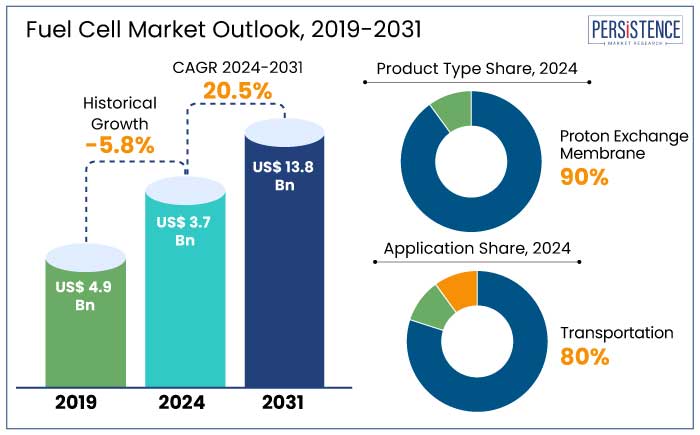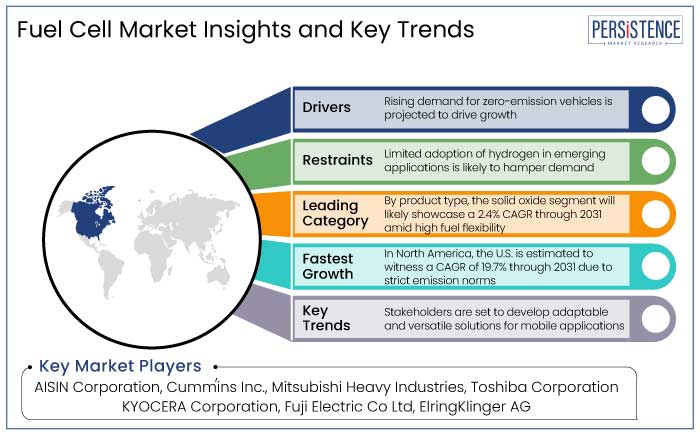Industry: Chemicals and Materials
Published Date: December-2024
Format: PPT*, PDF, EXCEL
Delivery Timelines: Contact Sales
Number of Pages: 190
Report ID: PMRREP33458
The global fuel cell market is projected to witness a CAGR of 20.5% during the forecast period from 2024 to 2031. It is anticipated to increase from US$ 3.7 Bn recorded in 2024 to a decent US$ 13.8 Bn by 2031.
Rising demand for Electric Vehicles (EVs) and robust government support for clean energy initiatives drive the global market. Several initiatives to reduce the carbon footprint are enticing various industries toward the use of fuel cells.
In 2023, around 14 governments signed a joint declaration to establish an International Hydrogen Trade Forum through the G20 summit in Goa, India. This forum aims to facilitate dialogue between hydrogen-importing and exporting countries. It also helps promote the international trade of hydrogen. Similar initiatives are anticipated to create new growth opportunities for market participants.

Key Highlights of the Market
|
Market Attributes |
Key Insights |
|
Fuel Cell Market Size (2024E) |
US$ 3.7 Bn |
|
Projected Market Value (2031F) |
US$ 13.8 Bn |
|
Global Market Growth Rate (CAGR 2024 to 2031) |
20.5% |
|
Historical Market Growth Rate (CAGR 2019 to 2023) |
-5.8% |
East Asia leads the global fuel cell market, holding a 50% share in 2024, with China contributing over 60% of the region’s market. The region is projected to witness a CAGR of 21.2% through 2031. This growth is driven by the rising adoption of EVs and robust government support for clean energy initiatives.
Apart from the transportation sector, hydrogen fuel cell technology is accelerating. For instance,
Proton Exchange Membrane (PEM) fuel cells are set to dominate the market, showcasing a strong CAGR of 20.3% through 2031. The segment will likely hold a share of around 90% in 2024.
The rising demand stems from several advantages, including flexibility in input fuel, compact and lightweight design, cost-effectiveness, and a durable electrolyte. These features make PEM fuel cells a preferred choice over other types, bolstering their market dominance. For instance,
The transportation segment leads the market with an approximate 80% share in 2024, driven by the growing global shift toward clean transport solutions. The segment is likely to witness a CAGR of 20.2% through 2031.
Increasing investments in emission-free initiatives across several countries bolster the segment. Fuel cells offer versatile applications, including material handling to enhance efficiency in warehouses and manufacturing facilities. These are also used in e-mobility, where they power delivery fleets, airport operations, long-haul trucks, and maritime activities.
The fuel cell market is set for substantial growth in the coming decade, pushed by the increasing adoption of zero-emission vehicles and the global shift toward clean energy solutions. Advances in fuel cell technology, such as improved efficiency, durability, and power density, are fueling this growth. Key innovations in Proton Exchange Membrane (PEM), solid oxide, and alkaline fuel cells are reshaping the market landscape.
Industrial applications of fuel cells are also on the rise, highlighted by Japan's Ene-Farm program, which installed 42,877 micro-CHP units in 2022. In contrast, Europe’s micro-CHP market faces challenges due to funding reductions and geopolitical disruptions like the Ukraine crisis.
Large-scale fuel cells for prime power and industrial CHP are gaining traction. Shipments had reached 325 MW in 2022, driven by companies like Bloom Energy and Doosan Fuel Cell.

The global fuel cell industry experienced a CAGR decline of -5.8% from 2019 to 2023, impacted by global disruptions like the COVID-19 pandemic and the Russia-Ukraine conflict. Additionally, technological limitations hampered market growth until 2022. However, the industry is now gaining momentum, particularly in logistics and freight transport, where demand for sustainable, low-emission solutions is rising.
Fuel Cell Vehicles (FCVs) are emerging as a preferred choice for long-haul operations due to their zero emissions, extended range, and faster refueling compared to battery electric vehicles. Expansion of hydrogen infrastructure, bolstered by government incentives, is further driving the integration of FCVs into logistics fleets.
Technological developments are reducing production costs, making fuel cells increasingly attractive to businesses seeking green practices. Companies are striving to meet regulatory standards and address consumer demands for sustainability. Fuel cells are hence playing a transformative role in reshaping the logistics and freight transport sectors. This shift positions the market for a strong rebound and sustained growth in the next ten years. For instance,
Such innovative strategies are set to foster demand for fuel cells over the forecast period. The global market is estimated to record a CAGR of 20.5% during the forecast period between 2024 and 2031.
Rising Demand for Electric Vehicles Globally to Push Sales
The global fuel cell industry is experiencing substantial growth driven by the rising adoption of Electric Vehicles (EVs) and robust governmental support for clean energy initiatives. For example,
Increasing competition among automakers is bolstering innovation and efficiency, leading to declining battery prices and improved vehicle affordability. Fuel cells are pivotal in various emerging EV technologies. Hence, their importance in the transition to sustainable energy systems is becoming increasingly evident, further propelling market growth. For instance,
Regulatory Pressures and Environmental Commitments to Boost Growth
The global fuel cell market is propelled by rising regulatory pressures and commitments to reduce carbon emissions, particularly in regions like the European Union (EU) and the U.S.
In the U.S., regulatory initiatives are accelerating the transition to clean energy. In March 2024, the Environmental Protection Agency (EPA) introduced strict emissions standards for light- and medium-duty vehicles, effective from the 2027 model year. These regulations, building on earlier greenhouse gas limits, aim to reduce air pollutants. At the same time, these focus on improving public health and lowering climate issues while saving drivers on fuel and maintenance costs.
Global collaborations are further pushing the development of hydrogen technology. For instance,
Limited Availability of Hydrogen Infrastructure to Hamper Growth
The fuel cell market faces significant constraints, particularly due to the limited adoption of hydrogen in emerging applications. The U.S. Department of Energy has invested US$ 7 Bn in clean hydrogen hubs. However, most hydrogen production still supports traditional sectors like refining and chemicals, which depend heavily on unabated fossil fuels. This reliance undermines the environmental advantages of hydrogen, hindering its potential to contribute to carbon neutrality.
In Europe, the Fuel Cells and Hydrogen Joint Undertaking forecasts that hydrogen could supply around 24% of the region’s total energy consumption by 2050. However, achieving this vision depends on overcoming infrastructure challenges and broadening the use of hydrogen technologies beyond established applications.
Sectors such as heavy industry and transport currently account for less than 0.1% of global hydrogen demand, revealing a significant gap. Significant role of hydrogen in these areas is essential for unlocking its full potential and driving market growth.
Growth in Fuel Cell Application beyond Transportation to Create Opportunities
The fuel cell industry is experiencing notable growth opportunities, particularly in mobile applications. Beyond traditional uses like telecommunications backup, there is a rising demand for large mobile systems designed for events and construction. According to Environmental Resources Management (ERM), these systems incorporate mobility features such as wheels or lift hoists, enabling broader applications beyond stationary setups.
While hydrogen fuel's high costs and logistical challenges remain obstacles, surging interest in portable solutions reflects a technology-driven market shift. For instance,
The units primarily serve industrial and consumer markets in Europe and North America, fostering innovation and efficiency improvements in fuel cell technology. As stakeholders focus on developing adaptable and versatile solutions, mobile applications are emerging as a key area of growth, paving the way for market growth in the next ten years.
The global fuel cell industry is in a rapid growth phase, driven by continuous innovation and increasing investment from both established and emerging players. Companies are accelerating fuel cell technologies by improving efficiency, durability, and power density, fueling supply-side growth. Substantial developments in solid oxide, Proton Exchange Membrane (PEM), and alkaline fuel cells are shaping the competitive landscape.
Emerging players are actively investing in hydrogen and fuel cell innovations. Global leaders are collaborating with regional technology providers to enhance efficiency and extend market penetration.
To meet growing demand, manufacturers such as Plug Power and Bloom Energy are extending production capacity with new facilities and automated lines. They are focusing on commercial and industrial applications. However, growth remains uneven and influenced by national policies, emphasizing the need for robust support to drive widespread adoption.
Recent Industry Developments
|
Attributes |
Details |
|
Forecast Period |
2024 to 2031 |
|
Historical Data Available for |
2019 to 2023 |
|
Market Analysis |
US$ Billion for Value |
|
Key Regions Covered |
|
|
Key Market Segments Covered |
|
|
Key Companies Profiled in the Report |
|
|
Report Coverage |
|
|
Customization and Pricing |
Available upon request |
By Product Type
By Application
By Region
To know more about delivery timeline for this report Contact Sales

Yes, the market is set to reach US$ 13.8 Bn by 2031.
The transportation sector is the main consumer that companies need to target.
India is estimated to witness a considerable share in 2024.
Doosan Fuel Cell Ltd, Ballard Power Systems, and Ceres Power are a few key manufacturers.
Yes, fuel cells for machines and commercial vehicles have the potential to become the future of infrastructure and transportation.